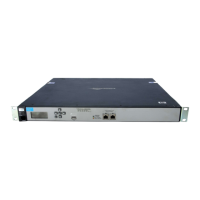CLI commands
bandwidth control internet-port low
Supported on: MSM710 MSM730 MSM750 MSM760 MSM765zl
bandwidth control internet-port low <min-tx-%> <min-rx-%> <max-tx-%> <max-rx-%>
Sets the bandwidth rates (Tx minimum, Tx maximum, Rx minimum, and Rx maximum) for traffic
classed as Low.
bandwidth control internet-port max-rate
Supported on: MSM710 MSM730 MSM750 MSM760 MSM765zl
bandwidth control internet-port max-rate<transmit>)<receive>)
Sets the maximum transmit and receive rates on the Internet port in kbps.
These settings enable you to limit the total incoming or outgoing data rate on the Internet port. If
traffic exceeds the rate you set for short bursts, it is buffered. Long overages will result in data
being dropped. To utilize the full available bandwidth, the transmit and receive limits should be
set to match the incoming and outgoing data rates on the Internet port.
Parameters
<transmit> Sets the maximum transmit rate in kbps.
<receive> Sets the maximum receive rate in kbps.
About bandwidth control
Bandwidth rates for each level are defined by taking a percentage of the maximum transmit and
receive rates defined for the Internet port. Each bandwidth level has four rate settings:
Transmit rate - guaranteed minimum: This is the minimum amount of bandwidth that will be
assigned to a level as soon as outgoing traffic is present on the level.
Transmit rate - maximum: This is the maximum amount of outgoing bandwidth that can be
consumed by the level. Traffic in excess will be buffered for short bursts, and dropped for
sustained overages.
Receive rate - guaranteed minimum: This is the minimum amount of bandwidth that will be
assigned to a level as soon as incoming traffic is present on the level.
Receive rate - maximum: This is the maximum amount of incoming bandwidth that can be
consumed by the level. Traffic in excess will be buffered for short bursts, and dropped for
sustained overages.
Bandwidth levels are arranged in order of priority from Very High to Low. Priority determines
how bytesToWrite bandwidth is allocated once the minimum rate has been met for each level.
Free bandwidth is always assigned to the higher priority levels first.
Assigning traffic to bandwidth levels
User traffic is assigned to a bandwidth level on a per-VAP (VSC) basis.
Management traffic (RADIUS, SNMP, management tool admin sessions) is assigned to
bandwidth level Very High and cannot be changed.
All traffic assigned to a particular bandwidth level shares the allocated bandwidth for that
level.
2-40

